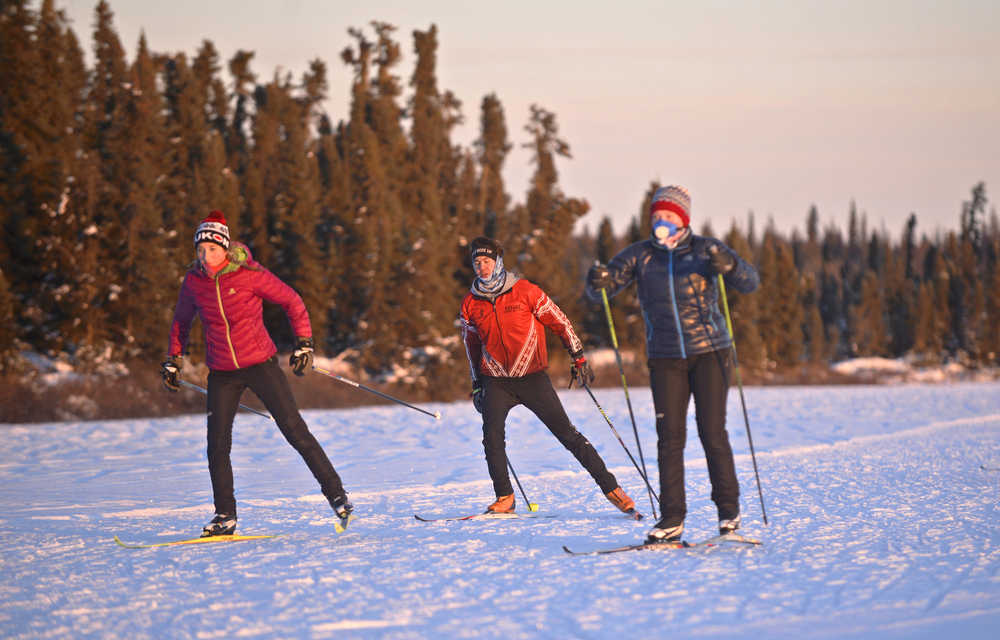The generous helping of snow that saturated the Kenai Peninsula within the past week has given new life to the winter wonderland, and it appears it isn’t going anywhere anytime soon.
With temperatures in the next week expected to stay below freezing, the opportunity to enjoy a legitimate winter and the activities that abound is now. Gone, for now, are the icy trails that plague skiers and snowshoers alike, as well as the pockets of dirt and bare ground that have hampered winter enthusiasts.
So, wondering where to go try out those new skis, boots, cleats or sled? The Kenai National Wildlife Refuge center has your answers.
A quick, easily accessible spot to go is Headquarters Lake at the center, which is located a short drive from Soldotna on Ski Hill Road near the intersection of Kalifornsky Beach Road and the Sterling Highway. The lake features a wide, groomed surface on the edges of the lake nearest to shore, giving skiers more than enough space to practice their skate style technique.
Scott Slavik, a visitor services specialist, has spent countless hours out working on trail maintenance and oversees much of the trail grooming around the refuge, as he has done for the past 26 years, the last half of those full-time with the center.
“Skate skiers love that open, flat, nicely groomed spot,” Slavik said.
As convenient as the lake is for local skiers, it can be tricky to maintain, Slavik said. The openness of the lake invites the opportunity for winds to distribute snow unequally and create drifts or other inconsistencies on the surface.
“We could work all day there and make it beautiful, and a puff of wind can erase it,” he said.
Headquarters is not the only lake available for use. Dolly Varden Lake, adjacent to Swanson River Road, is also usable according to Dan Saxton, although the trip is lengthier than the shorter skip over to Headquarters. Dolly Varden is accessible from the Kenai Spur Highway, past Nikiski.
“Some areas have six inches of snow, some are bare,” said Saxton, who maintains trails as part of his duties with the cabin crew. “The snow conditions on the lake can be variable, between crusty and wet.”
Saxton said Weed Lake is another option in the area, one which is smaller and a bit more protected from the wind.
As for the trails that crisscross through the woods surrounding the center, Slavik said the winter season is still young and thus no grooming has been done yet. Unlike a frozen lake, additional snow is needed to really form a sustainable base layer that can last for weeks, not days.
Unlike the Tsalteshi Trails, located less than a mile from the center, the refuge trails are primarily used for backcountry skiing, snowshoeing and hiking, but with the trees forming a shielding canopy overhead, it takes a while longer for a suitable layer of snow to pack in. Tsalteshi simply needs a few inches of snow for the trails crew to groom a skiable surface.
“We’re just trying to pack any snow we’ve got, but any snow we get later we’ll try to maintain the trails to a higher level,” Slavik said. “It just doesn’t have a packed base, but there’s sufficient snow.”
There are four trails around the visitor center, which will be celebrating its 75th anniversary Dec. 16 with a day of activities. The majority of the loops circle back to the center, but farther away from the Kenai and Soldotna town centers is the Skilak Wildlife Recreation Area, just outside of Sterling.
It offers seven trails for use, including a new addition that is still in the process of being established. The three-mile Marsh Lake Trail was formerly a bulldozer line that was created to help suppress the Card Street Fire in June 2015. Slavik said the refuge reclaimed that corridor to reform it into a public use trail, and the terrain lends itself to a family friendly route that features gently rolling hills.
Slavik added that the Funny River Horse Trail has seen some use from snowshoers and skiers as well. The trail is seven miles down Funny River road.
If flat terrain isn’t your thing, than perhaps a daytime jaunt up Skyline or the Fuller Lakes trails can cure the restlessness. Although the higher altitudes may seem like a tough challenge with higher winds and colder temperatures, Slavik said a clear day is worth it, and the trail is actually fine to use. Slavik said when hikers make their way up the trail, they produce what he calls a “stair step” experience, as the holes punched into the snow become the perfect spots to dig in.
“It’s almost a little easier, short of it being glare ice,” he said. “It’s almost easier in the winter because it’s like steps.”
Public use cabins also continue to be a very popular resource that the public enjoys, Saxton said, and there are 25 of them that dot the refuge.
Reach Joey Klecka at joe.klecka@peninsulaclarion.com.

